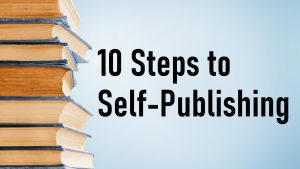 A lot of authors feel lost when it comes to self-publishing. When should they hire a professional? When should they forge ahead alone? And who can they ask for help?
A lot of authors feel lost when it comes to self-publishing. When should they hire a professional? When should they forge ahead alone? And who can they ask for help?
From editing to cover design to marketing your finished book, there’s a lot to consider. Below are 10 steps to self-publishing.
Step 1: Write a Book
This is the easy part. Truly, it is.
Before deciding which publishing options to pursue or beginning to search for editors and agents, a writer must first have a high-quality product to offer. Not adhering to the writing process actually kills writers’ chances because, without it, they are unable to produce a salable manuscript.
The writing process involves four phases: prewriting, drafting, revising, and editing. Prewriting is anything done before writing the first draft. It includes research, note taking, brainstorming, outlining, and world building. All first drafts are crap, thus revision is the key to a well written document. This where authors focus on the “big picture” and make the story reader centered. However, experienced writers know that problems can arise during drafting, revising, or editing that will send them all the way back to step one for more research or worldbuilding.
Learn more with these helpful posts:
Step 2: Edit the Novel
There are more types of editors than you can shake a stick at, and you’ll need several.
Self-publishers, eager to see their books in print, often ignore the undervalued topics of manuscript evaluation, revision, and editing. They do this at their peril. Flawed plot lines and inadequate character development are impossible to salvage after the book is published. To catch (and resolve) problematic aspects early in the writing process, the manuscript must be read by others, starting with its earliest draft forms.
Free editing resources include alpha readers, critique partners, and beta readers. Depending on the book’s content, it might be advisable to employ fact checkers and/or sensitivity readers before moving to other forms of editing. Also, depending on your skill level and editorial needs, consider the following:
- Editorial Assessments
- Structural Editing
- Developmental Editing
- Content Editing
The greatest gift self-publishers can give themselves is the gift of professional editing. After you’ve gotten the manuscript as far as you can on your own it’s time hire out the line editing, copy editing, and proofreading.
Learn more about editing with this post: Editing: From Alphas to Betas and Beyond
Step 3: Developing Readership
It does absolutely no good to publish a book if no one is going to read it. Developing an active and engaged readership should begin three years prior to publication. This starts with website development, contest submissions, publishing other works, membership in professional organizations, and effective use of social media. These form the basis for your author platform.
Author Platform: The ability to sell written content (books, short stories, magazine articles, etc) because of who you are or who you can reach.
Tools to build your platform include:
- Author Website
- Awards and Accolades
- Email Newsletters
- Networking
- Prior Publications
- Publicity
- Social Media Presence
These posts give in-depth information on several aspects of platform development:
- Building an Author Platform
- Building an Author Website
- Author Newsletters
- Make Writing Contests Work for You
Step 4: (Optional) Found a Publishing House
In order to compete with traditionally published books, many self-publishers choose to found their own publishing houses. Not only does this lend an air of professionalism to their writing endeavors, but it also serves to separate book publishing activities from personal income, providing a necessary level of legal and financial protection to self-publishers.
Learn more about founding a publishing house here: 10 Steps to Founding a Publishing House
Step 5: Cover the Business Basics
Even if you don’t found a publishing house, self-publishers still need ISBNs, barcodes, LCCNs, QR Codes, and to register with the secretary of state. All of these come with price tags, so you’ll need to create a budget for your book project. (Hint: there are more cost to come, so that budget is going to be a handy tool!)
You’ll also need to decide on which book distribution channels will best meet your needs and create quality meta-data so that your book will be searchable online.
More detailed information on book publishing business basics can be found in these posts:
- ISBNs, Copyrights, and Barcodes, Oh my!
- Book Distribution: What are your options?
- Metadata: SEO for your Book
- Budgeting for Publication
Step 6: Hire a Graphic Designer
Self-publishers need to put as much thought into their book’s cover as they do the content between the covers. Why? Because a great book with a horrible cover won’t sell, but a horrible book with a great cover will.
The smartest thing to do is hire a professional cover designer. Books require multiple covers in order to meet the size and file specifications of print, audio, and ebook platforms. Having the same person create all the necessary files at the same time will save time and money in the long-run.
A good cover will get readers to pluck your book off the shelf and thumb through it. Poor formatting, interior design, and typesetting will cause them to set it back down—costing you a sale. A well-formatted manuscript is vital for publishing success. That’s because, ultimately, readers care about readability. Many cover designers offer cover/interior formatting packages. That will ensure your print book looks professional and cover ebook conversion, too. As an added bonus many designers also create Facebook banners, book trailers, bookmarks, and other graphics necessary for marketing.
A good relationship between author and designer is an absolute must. It’s important to feel comfortable speaking candidly with the person you hired about your likes and dislikes. Also, quality cover artists know what’s trending in the marketplace for your genre and will be able to pick up on design elements that you miss. Hire someone you trust and know they want to see your book succeed just as much as you do!
If you book has a map, consider hiring a cartographer. You may also want to hire someone to create other files for your book, such as calendars, family trees, or other graphics, which enhances the value of your book.
Learn more about covers and formatting with these posts:
Step 7: Acquire Reviews
According to Jane Friedman the most essential first step for authors is reviews, not sales. Good reviews generate symbolic capital, which helps sell books. New and self-published authors have no symbolic capital, meaning they are an unknown in the book market. The key to a successful book launch is acquiring reviews before investing in public promotions.
There are lots of places to acquire reviews: loyal fans, community contacts, dedicated review sites, and book bloggers. Some places only accept books pre-publication, some only accept ebooks while others will accept ARCs and galleys. Also, some review sites are free, while others are paid. Regardless of the route you choose, it’s important to know what their rules for submission are.
Learn more about acquiring pre-publication book reviews here:
Step 8: (Optional) Submit to the AR Catalogue
If your intended audience is between the ages of 6 and 18, unless your book is listed in the Accelerated Reader (AR) catalog, it’s unlikely to be purchased by anyone. In order to be successful with the school-age demographic, authors need their books listed in the AR catalog.
Not all books are suitable for inclusion in the AR catalog. Before attempting to submit your book for consideration, take a moment to evaluate your book’s potential for inclusion. Common reasons books are rejected include: illustrations, insufficient text, lack of plausible distracters, poetry, poor formatting or style, reference material, how-to books, and undefined foreign words.
Learn more about the process for submission to the AR Catalogue here: Submitting to the AR Catalog
Step 9: Market Your Book
When authors think about marketing, they tend to envision an advertising campaign that magically draws people to their book. Marketing is defined as any activity an author undertakes in order to sell books. That means marketing is much, much more than just advertising.
The most common places authors think of for marketing are their website, social media, and Amazon. Overlooked marketing opportunities include:
- Advertising
- Book Reviews
- Book Tours
- Email Marketing
- Incentive Structures
- Media Outreach Campaigns
- Networking
- Podcasts
- Promotional Materials
And don’t forget to market in your own front and back matter!
Here is a step-by-step guild that walks authors through the various stages of book marketing and includes a downloadable checklist to keep authors on track: Introduction to Book Marketing
Step 10: Launch Your Book!
Congratulations, you’ve just birthed a book.
Planning for your book launch is a lot like planning for a new baby—it’s costly, time consuming, and covers a lot information new authors (and new parents) just aren’t familiar with. Think of your book launch as sending out a birth announcement. You know that baby’s coming, so make sure everything is in place ahead of time.
Here is list of tips and tricks for eager authors to make their book signing and launch party a success: Tips for Successful Book Signings
If you thought this post was useful, let me know in the comments!
